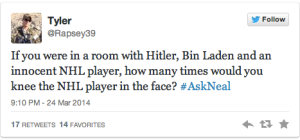This week we are looking at Public Relations crisis’ in social media. Being a huge hockey fan I decided to use the example of a twitter campaign that the Pittsburgh Penguins launched. They had a twitter take over by James Neal where fans could take to twitter to ask him questions using the hashtag #askNeal. Twitter take overs by professional athletes are a fairly common thing as its a popular tactic for teams to allow their fans to have a chance to have questions answered by the players. However, in this case it became a PR disaster. Ask the PR department of the Penguins thought this would be a good chance for fans to get to know James Neal and ask him questions other NHL fans, in particularly heated rival fans from Philadelphia Flyers, and Boston Bruins were salivating at the chance to stir the pot and troll the twitter world in full force. Why you may ask? It wasn’t just because they are fans of rival teams, its because of the questionable, and cheap shots Neal is known for throughout the league.
His most recent shot was a knee to the head of the Bruins Marchand for which he received a five game suspension. You can see the video the NHL released explaining the suspension here: http://www.youtube.com/watch?v=wwMezFGAze0
I have to admit, I went through all the tweets with the hashtag to the very beginning as I was following it the day it launched, and early on it was going quite well, fans were asking him questions such as his favourite food, what he would do if he wasn’t in the NHL, and common questions fans may want to know. This can simply be attributed to the fact that early on only Pittsburgh fans who follow the Penguins or James Neal on Twitter would have known about it, but as it got bigger word got out and things took a turn for the absolute worst. Tweets began flying in full force mocking Neal for his cheap shots and dangerous play.
As you can see it got quite hostile towards Neal and hockey fans began to make a complete joke of Neal, even his teammate Simon Depres tweeted at him which has since been deleted asking “Why are you so shy in the shower? #AskNeal”. The twitter campaign obviously became a complete disaster and crisis for Neal as he was faced with the embarrassment of having himself ridiculed by almost everyone who knew about this twitter campaign.
In this type of situation the Penguins need to remedy the situation by acting quickly and efficiently. They should have addressed fans in a positive matter and managed their own players such as Simon Depres who as a public figure had the most retweets and favourites as anyone for mocking his own teammate.
Secondly although it may be to late, it was worth a shot for James Neal to try and address his critics and apologize for his actions. One of the reasons he is disliked so much is because he shows no remorse for his actions and cheap shots he is known for. Shots to the head in the NHL are taken very seriously with the new concussion protocols to protect players and when Neal was suspended for his knee to the head of Marchand instead of apologizing he actually laughed and said “Probably wasn’t the smartest thing I’ve done”. He answered negative tweets in a very sarcastic manner which fueled the fire even further such as this one:
He also posted a very sarcastic tweet after the fact which shows his complete disregard or worry for the negativity towards him
The Penguins PR department should have thought this through a lot more then they did. If this was done as an attempt to regain credibility towards Neal and strengthen his reputation then they should have done something else. With a twitter campaign by a player with a bad reputation, putting him somewhere to be ridiculed by the free speech of the internet and NHL fans is a death sentence. They should have used a tactic that would allow them to show who Neal is away from hockey, or express him in a way fans may not know him. Show a video of his charity contributions, he dedication to community building, or other light hearted means that could help strengthen the public opinion of him.
Overall, to say this twitter take over was a disaster would be a complete understatement. And hey, I even got in on the fun after reading through hundreds of tweets, admittedly laughing through most of it…










